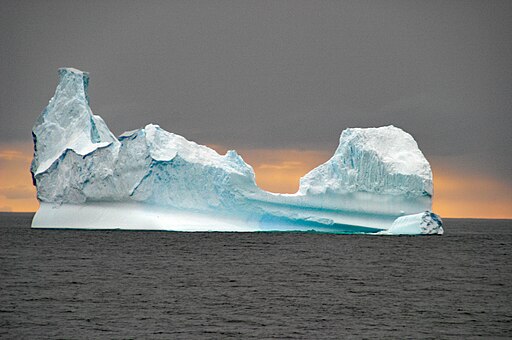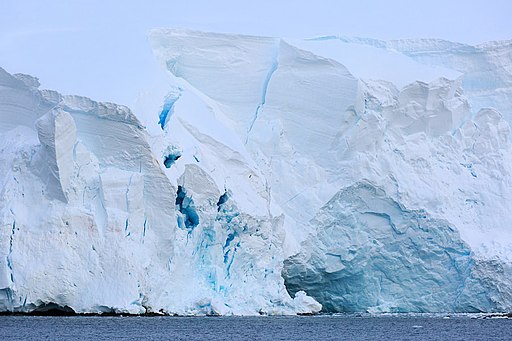A glacier is a large, slow-moving mass of ice on land, while an iceberg is a piece of glacier ice that has broken off and floats in the ocean.
Glacier Vs. Iceberg
- Formation: Glaciers form on land, while icebergs form in water.
- Location: Glaciers are typically found in cold regions near the poles or high mountains, while icebergs can be found in oceans and seas around the world.
- Size and Shape: Glaciers are much larger in size compared to icebergs. Icebergs can vary in size, with some being as small as a house or as large as a small country. Icebergs also come in various shapes, influenced by the specific dynamics of their formation.
- Composition: Glaciers are made up entirely of ice, whereas icebergs can contain a mixture of ice, snow, and other materials trapped within the ice as it formed.
- Movements: Glaciers slowly move downhill under their own weight, while icebergs can be carried by ocean currents and wind, resulting in their movement in the water.
What is a Glacier?

Glaciers are massive bodies of ice that form from the accumulation and compaction of snow over many years. They are found in areas where the snowfall exceeds its melting rate, causing layers of snow to build up and compress into dense ice. Over time, the weight of the ice causes it to flow downhill under the force of gravity.
There are different types of glaciers, such as valley glaciers, ice sheets, and tidewater glaciers. Each type forms under specific conditions and exhibits unique characteristics.
Definition and Formation of a Glacier
Glaciers are massive bodies of ice that form over long periods of time. They are created through the process of compacting and recrystallizing snow into ice. The “Definition and Formation of a Glacier” is a large persistent body of ice that moves very slowly due to its own weight.
Glaciers form in areas where the accumulation of snow exceeds its melting rate. Over time, the weight of the accumulated snow compresses the lower layers and forms ice. This process, known as “firnification,” leads to the formation of granular ice. Eventually, the granular ice becomes denser and transforms into “solid ice.” This transformation is called “glacial ice.”
The “formation of a glacier” requires specific conditions, including cold temperatures and high snowfall. It typically occurs in mountainous regions where the snow remains year-round and accumulates over time. As more snow accumulates, the pressure from the upper layers compresses the lower layers, causing them to turn into ice.
Glaciers are dynamic features that constantly move under their own weight. Their movement is influenced by gravity and the shape of the underlying terrain. They flow like slow-moving rivers, carving out valleys and shaping the landscape.
The “definition and formation of a glacier” involve the transformation of snow into ice through compression and recrystallization. The process requires cold temperatures, high snowfall, and time. Glaciers are remarkable natural phenomena that shape the Earth’s surface through their slow and constant movement.
Consider exploring more about the fascinating world of glaciers and their impact on our planet.
Types of Glaciers
- Alpine glaciers: These glaciers form in mountainous regions and flow down valleys. They are characterized by their steep slopes and often have crevasses.
- Continental glaciers: Also known as ice sheets, these glaciers cover vast areas of land. They are found in polar regions such as Greenland and Antarctica. Continental glaciers are much larger than alpine glaciers.
- Hanging glaciers: These glaciers are suspended on steep slopes or cliffs. They are often found in mountainous regions and are named for their position above the main glacier.
- Tidewater glaciers: These glaciers flow directly into the ocean. They can be found in coastal areas and often calve icebergs into the water.
- Piedmont glaciers: These glaciers occur when a valley glacier spreads out onto a flat plain. They are characterized by their fan-shaped appearance.
When considering different types of glaciers to learn more about or visit, it is important to take into account your preferences and interests. If you are a fan of hiking and mountaineering, exploring alpine glaciers may be the most suitable option for you.
If you have an interest in polar environments and a desire to witness the grand scale of a glacier, visiting a continental glacier like those in Greenland or Antarctica could be the most rewarding experience.
For those seeking unique and awe-inspiring landscapes, the hanging glaciers or tidewater glaciers might provide a captivating adventure. Ultimately, a good understanding of the various types of glaciers will enable you to select an expedition that aligns with your interests and goals.
What is an Iceberg?

An iceberg, on the other hand, is a large piece of ice that breaks off from the edge of a glacier or an ice shelf and floats in the water. Icebergs are formed when chunks of ice, called calved ice, separate from the main glacier or ice shelf due to various factors such as melting or the movement of the glacier itself.
Icebergs come in different types based on their shape and size. Common iceberg shapes include tabular, wedge, and domed, each defined by its distinctive appearance.
Definition and Formation of an Iceberg
Icebergs, which are large pieces of ice that detach from glaciers and drift in the water, are formed through a natural process known as calving. The initial stage of iceberg formation begins with the accumulation of snow on land. Over time, this snow undergoes compression and transforms into thick layers of ice, forming glaciers. Due to their own weight and the gravitational force, these glaciers gradually descend downhill. As they approach a body of water, such as the ocean or a lake, the ice starts to fracture and create icebergs.
The dimensions and structure of icebergs can significantly vary, with some attaining extraordinary heights and sizes. These frozen masses can extend for hundreds of meters and weigh millions of metric tons. Comprised primarily of frozen freshwater sourced from the glaciers, icebergs present a unique composition.
One defining characteristic of icebergs is their propensity to be carried by ocean currents and winds, resulting in their constant movement in the water. This movement can occasionally pose a hazard to ships and maritime navigation. The polar regions, particularly around Antarctica and Greenland, boast the largest concentration of icebergs.
To summarize, icebergs are the outcome of the calving process, characterized by the detachment of substantial ice chunks from glaciers and their subsequent presence in the water. Their size, shape, and composition display considerable variation, and their mobility is influenced by the interplay of ocean currents and winds.
Types of Icebergs
Glaciers can give rise to various types of icebergs depending on their characteristics and how they break off into the ocean. Below is a table showcasing different types of icebergs:
| Type | Description |
| Tabular Iceberg | A wide and flat iceberg with steep sides and a flat top. It resembles a table or plateau. Tabular icebergs are the most common type. |
| Pinnacled Iceberg | An iceberg with one or more tall, jagged peaks. These icebergs are formed by erosion and breakage of the ice. |
| Dome Iceberg | A rounded and smooth iceberg resembling a dome or a mushroom. Dome icebergs are often formed by melting and refreezing of ice. |
| Wedged Iceberg | An iceberg that has become stuck in shallow water or between other icebergs. They can be a potential hazard for ships. |
| Drydock Iceberg | An iceberg with a hollow cavity, resembling a drydock or a large tunnel. They are formed when a part of the iceberg melts, leaving a cavern-like structure. |
Each type of iceberg has its own unique characteristics that contribute to their formation and appearance. Understanding the different types of icebergs can enhance our knowledge of the diverse ice formations found in polar regions.
Key Differences Between Glacier and Iceberg
When it comes to glaciers and icebergs, understanding the key differences is essential. From their formation to their composition, location, size, shape, and even their movement, each aspect sets them apart in fascinating ways. Get ready to dive into the intriguing world of glaciers and icebergs, as we uncover the distinctive characteristics that define these frozen wonders of nature. So, let’s embark on this journey to unravel the secrets behind the formation, location, size and shape, composition, and movements of these magnificent icy marvels.
Formation
is a crucial aspect when it comes to understanding the difference between glaciers and icebergs. To better comprehend this, let’s take a look at the formation process of these natural wonders through an organized table:
| Formation of Glaciers | Formation of Icebergs |
|---|---|
| Glaciers are formed through the accumulation and compaction of snow over many years. As more snow falls, the weight compresses the lower layers, turning them into ice. This process also requires freezing temperatures and steep slopes. | Icebergs are formed when chunks of ice break off from the edge of glaciers or ice shelves. This process, known as calving, occurs due to gravity, ocean currents, and warming temperatures. |
Understanding the formation of glaciers and icebergs is essential in comprehending the inherent differences between the two phenomena. While glaciers form through the accumulation and compaction of snow over time, icebergs originate from the fragmentation of glaciers or ice shelves due to various environmental factors.
It is fascinating to learn about the formation of these natural wonders and how they contribute to the Earth’s unique landscapes throughout history.
Location
Glaciers and icebergs form in different locations. Glaciers are mainly found in polar regions and high mountain ranges, while icebergs are found in colder oceans, particularly in the Arctic and Antarctic regions.
Glaciers develop in areas where there is sufficient snowfall and cold temperatures for the accumulation and compaction of snow over time. This process occurs over hundreds or even thousands of years. Consequently, glaciers are often located in regions with colder climates and higher elevations, such as Greenland, Alaska, and the Himalayas.
On the other hand, icebergs are large chunks of ice that break off from glaciers and float in the ocean. They are present in colder oceans where glaciers reach the sea, such as the Arctic and Southern Oceans. Icebergs can drift with ocean currents, traveling far from their original location.
The locations of glaciers and icebergs are influenced by factors such as temperature, precipitation, and sea ice formation. Warmer temperatures and melting ice can cause glaciers to retreat or disappear completely, impacting the presence of icebergs in certain areas.
When selecting where to study or explore glaciers or icebergs, it is vital to consider their specific locations and the accessibility of these areas. It is also crucial to keep in mind the safety precautions and environmental impact of such activities in these delicate ecosystems.
Glaciers are typically found in polar regions and high mountain ranges, while icebergs are primarily located in colder oceans. Understanding the location of these frozen water formations is essential for studying and appreciating their unique characteristics.
Some suggestions for further reading on glaciers and icebergs include scientific research articles, books on climate change and polar exploration, and documentaries showcasing the beauty and significance of these frozen landscapes.
Size and Shape
- A glacier can vary in size and shape from small, less than 1 acre, to massive, covering over 1 million acres.
- Icebergs can range in size and shape from small ice chunks to massive structures that can be larger than a city.
- The shape of a glacier is typically elongated and can have a variety of features such as crevasses, seracs, and icefalls.
- Icebergs come in various shapes and can be tabular, wedge, dome, or pinnacle-shaped, depending on their formation.
- Glaciers have a distinct blue color due to the compression of ice crystals, which absorbs most of the color spectrum except blue.
- Icebergs can appear white due to air bubbles trapped in the ice, or they can have blue streaks or bands caused by compressed ice.
- The size and shape of glaciers can change over time due to melting, calving, and movement.
- Icebergs can change shape and size through melting, flipping, or breaking apart, often due to the effects of waves, currents, and melting.
Composition
The composition of glaciers and icebergs can vary based on several factors. The table below provides a comparison of the composition of glaciers and icebergs:
| Composition | Glaciers | Icebergs |
| Ice | Consist mainly of compacted snow and ice. | Comprised of freshwater ice that has broken off from glaciers. |
| Impurities | May contain small amounts of rock debris, dirt, and other sediment carried by the glacier. | Can contain a variety of impurities such as soil, rock fragments, and even marine organisms. |
| Salinity | Glacial ice is typically fresh and contains minimal salinity. | Icebergs, made from glacial ice, are also generally considered fresh, but may have slightly elevated salinity due to contact with seawater. |
| Density | Glacier ice is denser compared to icebergs. | Icebergs have a lower density due to trapped air pockets and impurities. |
When considering the composition of glaciers and icebergs, it is important to note that the specific characteristics can vary depending on the particular glacier or iceberg in question. Factors such as location, climate conditions, and the history of the glacier or iceberg can all influence their composition.
When choosing the best bottled water, it is crucial to take into account factors like the water quality, serving circumstances, taste preferences, and health goals. Understanding the different types of water, such as artesian well water, mineral water, spring water, and sparkling water, can help in making an informed decision. It is also important to consider aspects like the unique premium waters available for special occasions or the varied tastes and packaging of natural waters. If health goals are a priority, one can choose mineral water to supplement mineral intake based on individual needs. By considering these factors, one can find the best bottled water brand that suits their preferences and requirements.
Movements
| Movements | |
| Glacier | Iceberg |
| Glaciers move due to the force of gravity acting on the ice mass. | Icebergs also move due to the force of currents and winds in the water. |
| The movement of glaciers is typically slow, with speeds ranging from a few centimeters to several meters per day. | Icebergs can move at varying speeds, depending on the strength of the currents and winds. Some icebergs can travel at speeds of several kilometers per day. |
| The movement of glaciers can be affected by factors such as the slope of the terrain, the amount of snowfall, and the presence of meltwater. | The movement of icebergs is influenced by ocean currents and tides, as well as the shape and size of the iceberg. |
| Glacial movement can result in the formation of crevasses and other features on the surface of the ice. | Iceberg movement can cause changes in shape and size, as well as the breaking off of smaller pieces known as “calving”. |
Similarities Between Glacier and Iceberg
Glaciers and icebergs may seem distinct, but let’s explore the surprising similarities that connect these icy wonders. Delving into their relationship with glaciers and how they float in water, we’ll uncover intriguing facts and fascinating aspects that bridge the gap between these awe-inspiring formations. Get ready to dive into the frozen world of glaciers and icebergs, and discover the unexpected parallels that exist between them.
Relationship with Glaciers
Glaciers and icebergs share a unique relationship with each other. When glaciers undergo the process of melting, they actively contribute to the formation of icebergs. This natural phenomenon initiates when a fragment of ice detaches from a glacier and plunges into a nearby body of water, be it a lake or the vast ocean. This detached ice fragment subsequently transforms into what we commonly refer to as an iceberg.
The ultimate size and shape of an iceberg are fundamentally determined by the size and shape of its originating glacier. It is an established fact that larger glaciers possess the capacity to generate colossal icebergs, whereas smaller glaciers give rise to comparatively smaller icebergs. It is important to note that the composition of an iceberg is also greatly influenced by the characteristics of the glacier from which it originates. In the event that the glacier contains a substantial amount of dirt and debris, the resultant iceberg may exhibit a tarnished appearance or feature a speckled texture.
Once formed, icebergs possess the remarkable ability to drift away from their parent glaciers, embarking on extensive journeys facilitated by ocean currents and prevailing winds. As a consequence of this movement, icebergs are sometimes transported to regions where they pose potential hazards to ships and boats. Furthermore, as icebergs gradually undergo the natural process of melting, they release freshwater into the surrounding ocean, inevitably having an impact on the delicate balance of marine ecosystems.
The intricate relationship between glaciers and icebergs is deeply intertwined. Icebergs are essentially born from the occurrence of ice fragments breaking away from glaciers and submerging themselves into bodies of water. The characteristics of icebergs, including their size, shape, and composition, are directly influenced by the original glacier from which they originate. Moreover, as icebergs undergo the process of melting, they release freshwater into the ocean, consequently affecting the intricate web of marine life.
Floating in Water
Glaciers and icebergs possess a significant similarity in terms of their behavior in water. Both glaciers and icebergs have the remarkable ability to float in water, which is primarily attributed to their composition and density.
When glaciers or icebergs take shape, they consist of tightly compressed snow and ice. This snow and ice have a lower density compared to the water in which they float. This disparity in density allows the glacier or iceberg to displace an equal amount of water to its own weight, granting it the capability to float gracefully.
The phenomenon of glaciers and icebergs floating in water is not only captivating but also carries crucial implications. It impacts ocean currents as the melting of these frozen entities can introduce substantial quantities of freshwater into the ocean. Consequently, this influx of freshwater has the potential to influence salinity levels and marine ecosystems significantly.
Furthermore, the buoyant inclination of icebergs also poses a potential hazard to ships, particularly due to their immense mass and size. The presence of icebergs can prove to be perilous if they collide with vessels.
The ability to float in water serves as a shared characteristic between glaciers and icebergs. Understanding this behavior and the contributing factors assumes utmost importance in comprehending the impact of these frozen marvels on the ecosystems of our planet and maritime activities.
True Historical Fact:
In 1912, during the tragic maiden voyage of the RMS Titanic, the ship encountered a catastrophic collision with an iceberg in the North Atlantic Ocean. This calamity shed light on the perilous nature of icebergs and prompted significant advancements in iceberg detection and navigation techniques to avert comparable disasters in the future.
Frequently Asked Questions
What’s the difference between a glacier and an iceberg?
A glacier is a large accumulation of ice, snow, rock, sediment, and water that moves down slope under its own weight and gravity. On the other hand, an iceberg is ice that has broken off from glaciers or shelf ice and is floating in open water.
How are glaciers and icebergs formed?
Glaciers are formed through the continual deposition of snow that transforms into ice and compresses air pockets over hundreds of years. Icebergs are formed when chunks of glaciers break off and float on the water.
Where are glaciers and icebergs typically found?
Glaciers are generally found in mountain valleys or polar regions, while icebergs float on water bodies such as oceans.
What are the differences in size between glaciers and icebergs?
Glaciers are much larger than icebergs because they are formed over hundreds of years. Icebergs, on the other hand, are smaller as they are pieces that break off from glaciers and float on water.
How much of an iceberg is visible above water?
Only the tip of an iceberg is visible above water, with over 90% submerged. The majority of their structure lies beneath the surface.
How do glaciers and icebergs contribute to climate change?
Glaciers and icebergs play an important role in climate science as indicators of climate change. Melting glaciers could significantly raise global sea levels, while icebergs breaking off from glaciers contribute to the movement of freshwater and redistribution of heat in the ocean.
Image Credits
Featured Image By – Георг Боц, CC BY-SA 3.0 , via Wikimedia Commons
Image 1 By – MusikAnimal, CC BY-SA 4.0 , via Wikimedia Commons
Image 2 By – W. Bulach, CC BY-SA 4.0 , via Wikimedia Commons









